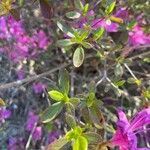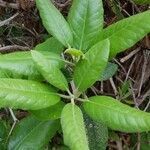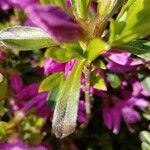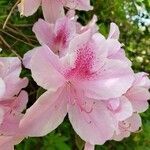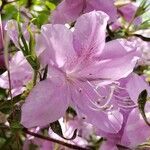Shrubs or trees, to 3.5(-6) m, sometimes rhizomatous. Stems: bark smooth to vertically furrowed, shredding; twigs multicellular eglandular-hairy (hairs branched basally, crisp/matted), glabrate in age. Leaves persistent; petiole multicellular-hairy (hairs ± branched), often glabrescent; blade elliptic to obovate or slightly ovate, (5-)6-12(-17) × (2.5-)3.5-6(-7.7) cm (length/width ratio 1.3-3.5), thick, coriaceous, margins entire, revolute to plane, glabrous or sparsely hairy along margins (hairs branched, ephemeral), apex rounded/mucronate to obtuse or acute, surfaces sparsely eglandular-hairy (hairs basally branched, crisped, quickly deciduous), abaxial surface minutely, obscurely papillose. Floral bud scales multicellular stipitate-glandular-hairy, eglandular-hairy (hairs basally branched, crisped), and unicellular-hairy (hairs short to elongate), margins eglandular-hairy (hairs branched). Inflorescences 12-20-flowered; bracts similar to bud scales. Pedicels 10-50 mm, sparsely to moderately multicellular eglandular-hairy (hairs ferruginous, branched, crisped), glabrate in age. Flowers opening after development of leaves (of flowering shoots), erect to horizontal, fragrant; calyx lobes 0.5-1.7 mm, glabrous or eglandular-hairy; corolla deep pink to purple, rarely white, usually with yellowish-green spots on upper lobe, campanulate, 27-50 mm, glabrous on outer surface, petals connate, lobes 15-30 mm, tube gradually expanding into lobes, 12-28 mm; stamens 10, included, ± unequal, 19-39 mm; (ovary multicellular eglandular-hairy). Capsules borne on erect pedicels, 10-23 × 3.5-7 mm, eglandular-hairy (hairs ferruginous, branched). Seeds without distinct tails, flattened portion of testa well developed at each end; testa expanded, dorsiventrally flattened, loose. 2n = 26.
More
Shrub or small tree to 6 m; lvs leathery, evergreen, oval or elliptic, 5–15 cm, broadest near the middle, rounded to subacute at both ends, glabrous; fls lilac-purple, somewhat larger than in no. 1 [Rhododendron maximum L.] ; pedicels and ovary hirsutulous, not glandular; sep broadly triangular or semicircular, under 1 mm; fr 20–25 mm. Mt. woods; Va. to Ky., s. to Ga. and Ala. May, June.
